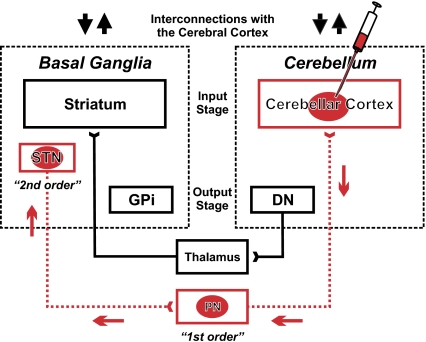Fig. 1.
Experimental paradigm and circuits interconnecting basal ganglia and cerebellum. We injected rabies virus (RV) into regions of the cerebellar hemisphere. The virus went through two stages of transport: retrograde transport to first-order neurons that innervate the injection site and then, retrograde transneuronal transport to second-order neurons that innervate the first-order neurons. The red arrows indicate the direction of virus transport. Previously, we have shown that an output stage of cerebellar processing, the dentate nucleus (DN), has a disynaptic connection with an input stage of basal ganglia processing, the striatum (4). In this experiment, we demonstrate a reciprocal connection from the subthalamic nucleus (STN) to the input stage of cerebellar processing, the cerebellar cortex. These interconnections enable two-way communication between the basal ganglia and cerebellum. Each of these subcortical modules has separate parallel interconnections with the cerebral cortex (up and down black arrows). DN, dentate nucleus; GPi, internal segment of the globus pallidus; PN, pontine nuclei; STN, subthalamic nucleus.

